It was hard not to notice the world-class photographer’s stunning portfolio displayed on his laptop right next to mine. Although we were complete strangers, we invaded each other’s personal space. We sat squished next to each other in very cramped seats on a very full flight to Bangkok. Our conversation bounced from his job as a global freelance photographer to our family sabbatical through Southeast Asia. As I shared the details of our Myanmar itinerary, including visiting the Long Neck women, his tone subtly changed from interest to judgment. It went something along the lines of this:
KELLIE: “We’re going to all the typical places like Yangon, Inle Lake, Bagan, and Mandalay, but we’re also going to Loikaw to visit the ethnic tribes. I’m SO excited about that part.”
PHOTOGRAPHER: “Are you sure about that?”
KELLIE: “Sure about what?”
PHOTOGRAPHER: “There’s a lot of negative publicity about the unethical exploitation of the Long Neck women and how they’ve turned into human zoos. This is really frowned upon. You might want to rethink it.”
And just like that, the ethical travel seeds of doubt were planted.
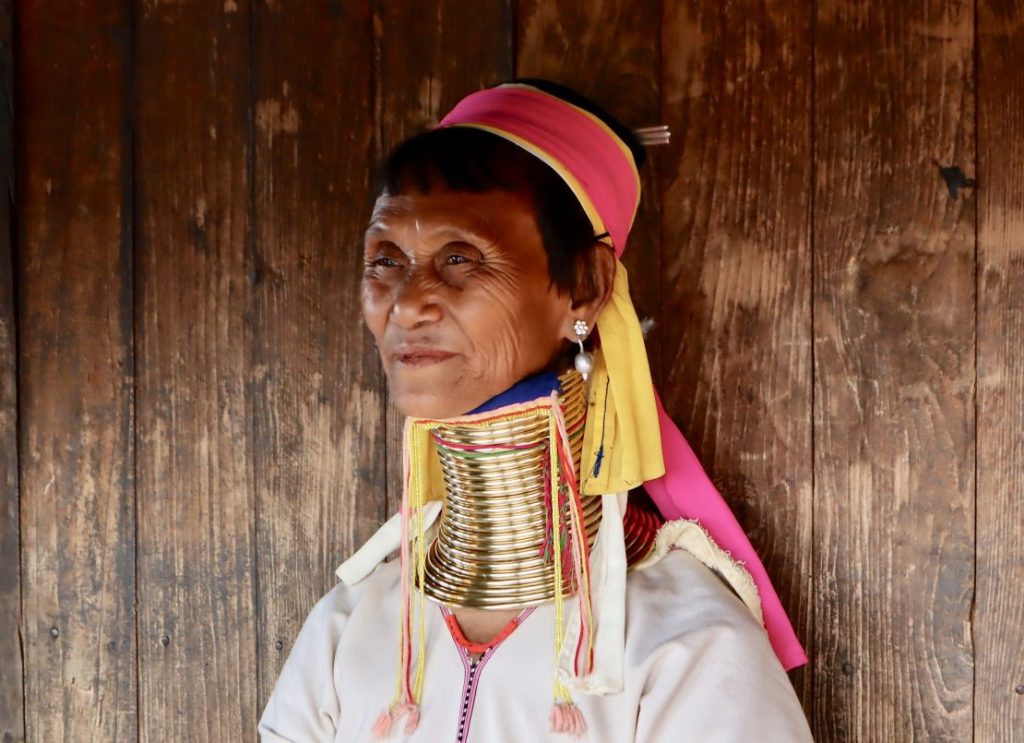
History of Long Neck (Giraffe) Women in Thailand
As my seatmate and many travel bloggers have reported, the Kayan Long Neck villages (officially known as the Padaung) in Thailand have turned into human zoos. Busloads of selfie-snapping tourists make day trips from Chiang Mai and surrounds to glimpse this ancient fashion statement.
What many of these tourists don’t realize is that the Kayan tribe is not from Thailand. The Long Neck women in Thailand are actually refugees from the Burmese minority group, Karen. They fled Myanmar (Burma) during the civil war in the 1980’s and found safety in Thailand along the Thai/Myanmar border.
The Thai government quickly realized that the unique tradition of wearing brass neck rings is a tourist magnet. Most negative reports regarding the exploitation of the minority group are based on the mass tourism visits to the Thailand refugee camp, not to the actual Kayan Village in Myanmar.
The Ethical Cultural Travel Dilemma
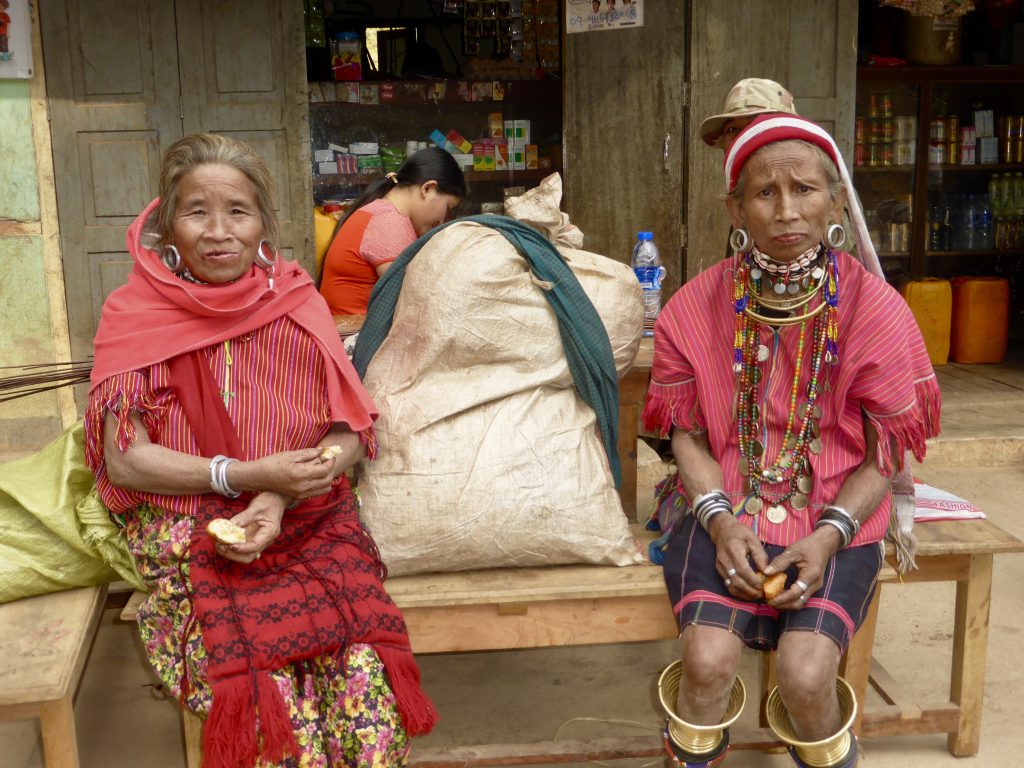
Ethical cultural travel is a very real dilemma. By nature, travelers seek to explore deeply and authentically. They are not satisfied with just looking at the soul-stirring pictures in National Geographic. They want to experience them.
At the same time, it is critical to protect and preserve the ethnic groups’ customs, dignity, privacy and way of life.
Is it even possible to create a win-win for both travelers and ethnic groups? A way for travelers to experience the most intriguing cultural groups in the world without turning them into human zoos?
Enter Community Based Tourism.
What is Community Based Tourism (CBT) in Myanmar?
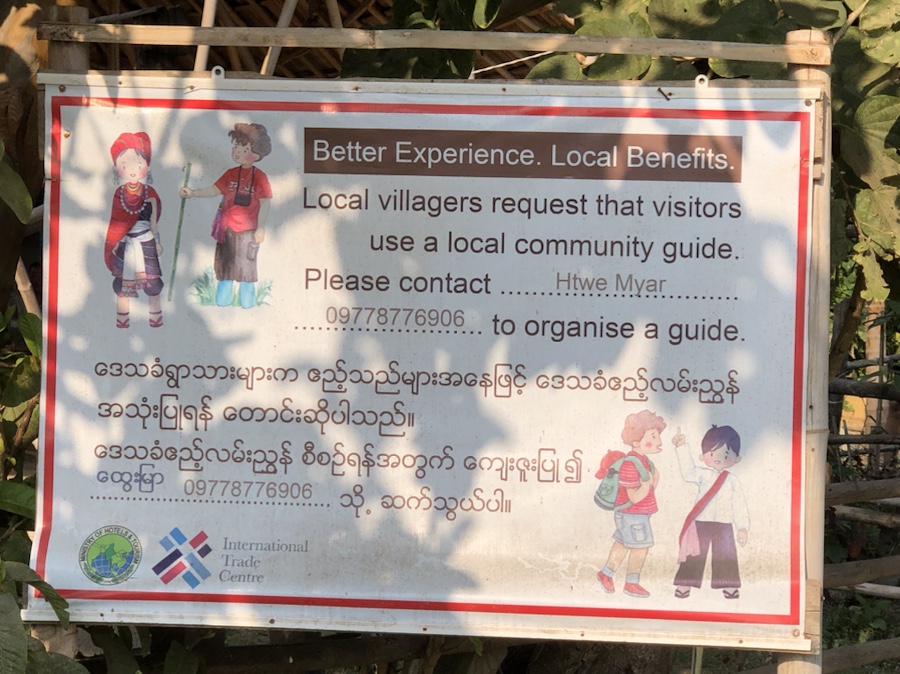
Community Based Tourism (CBT) partners those ethnic villagers who want to share their culture with travelers who want to experience it. It is a controlled tourism that funnels tourist dollars (or Myanmar Kyats) into a village and provides an authentic, meaningful experience for travelers.
Village guides serve as hosts and escort tourists to meet with villagers who want to participate in this cultural exchange. This CBT model is a win-win for everyone.
Besides, independent travelers wouldn’t have a meaningful experience without a guide (or two). The languages spoken by Myanmar’s tribes are not available on Google Translate. Most visitors will require two translators to ensure a meaningful visit. The first guide will translate English into Burmese, and then the village guide translates Burmese into the tribal language.
Visiting Myanmar’s Karen Tribes: Kayan, Kayaw, and Kayah
To visit Myanmar’s Karen tribes you will want to base yourself in Loikaw. Keeping all of the K-tribes straight is no easy task. It can be easy to forget which name goes with which group. What you won’t forget, though, is your time spent visiting them. Following are the three tribes that are easily visited as day trips from Loikaw: Kayan, Kayah, and Kayaw.
1. Kayan Tribe: The Long Neck Women
The most famous and recognizable of Myanmar’s 135 ethnic groups are the Padaung women, also known as long-neck or giraffe women, who live in Pan Pet Village. Despite the nickname, the women’s necks aren’t actually elongated. The solid brass rings (it is actually a coil) depress the collar bones making the neck appear longer than normal.
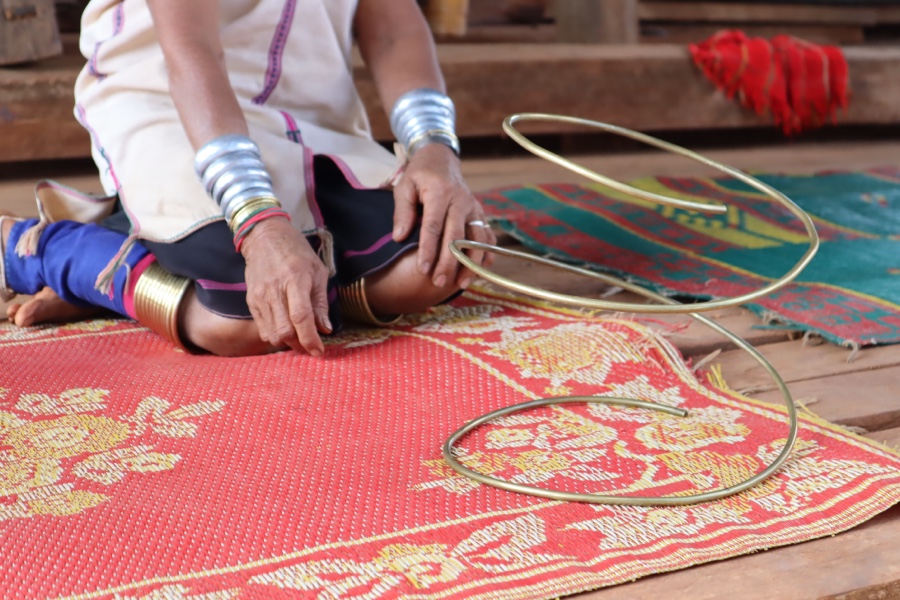
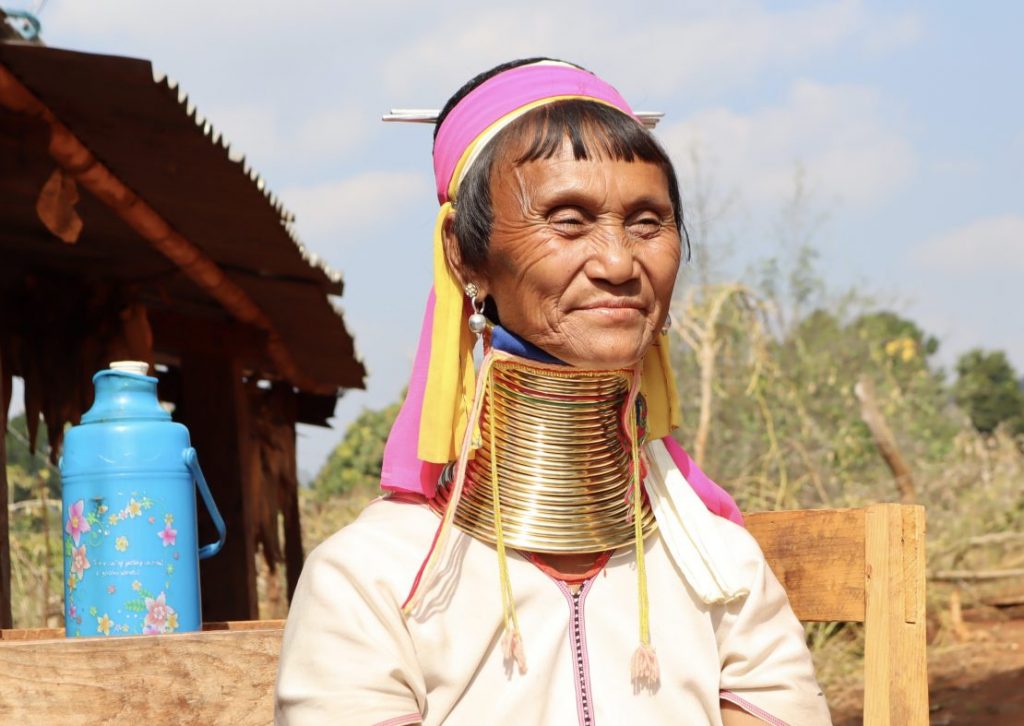
Our first visit was with Daw Mu Htan. Within two minutes of meeting her, I knew that I’d met a kindred spirit. After pouring four cups of tea, we sat down to get acquainted.
Tossing all Southern etiquette aside, I asked my first question:
KELLIE: “How old are you?”
DAW MU HTAN: “68”
KELLIE: “You don’t look at day over 39.”
DAW MU HTAN: “How old are you?”
KELLIE: “49”
DAW MU HTAN: “You don’t look a day over 29.”
And that was all it took. We had connected. Despite talking through two translators, she got my humor and I got hers.
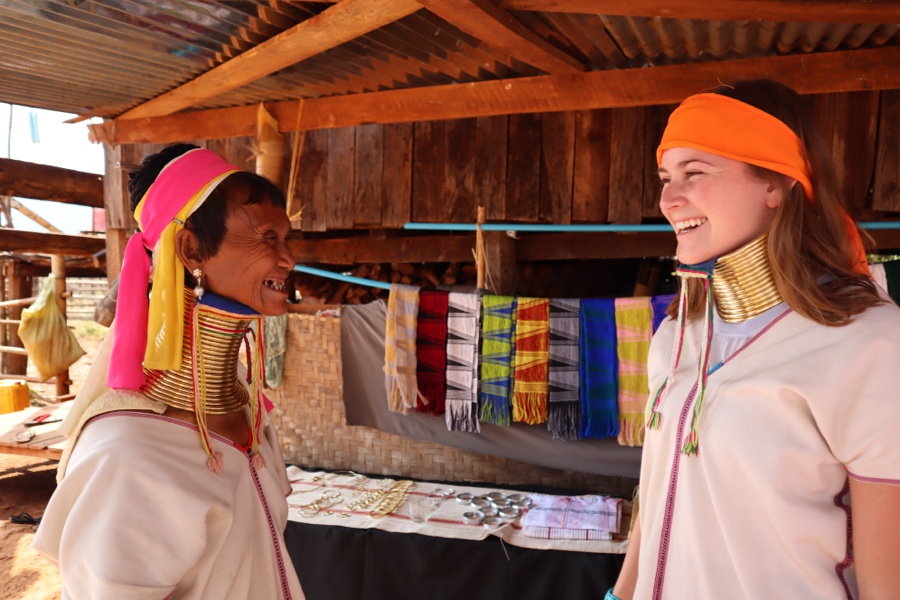
She immediately reminded me of my mom–a woman whose tiny body couldn’t contain her huge spirit.
We spent the next hour discussing everything from the tradition of wearing the brass neck rings (she views it as an honor), to the challenges of raising teenagers, to scrolling through my mother’s Facebook account. We laughed, we danced, and we even recorded a message to my mom from her.
After many hugs and her insistence that I bring my mother to meet her on a future visit, my family was sad to say goodbye.
And I genuinely believe she was too.
Dha Mu Ayea, the Smallest “Giraffe” Woman
Next our guide took us to meet another neighbor, Dha Mu Ayea. She proudly informs us that she is the smallest giraffe woman. She started wearing the rings when she was 7 years old (she started with nine rings). Now the brass coil circles her neck 27 times.
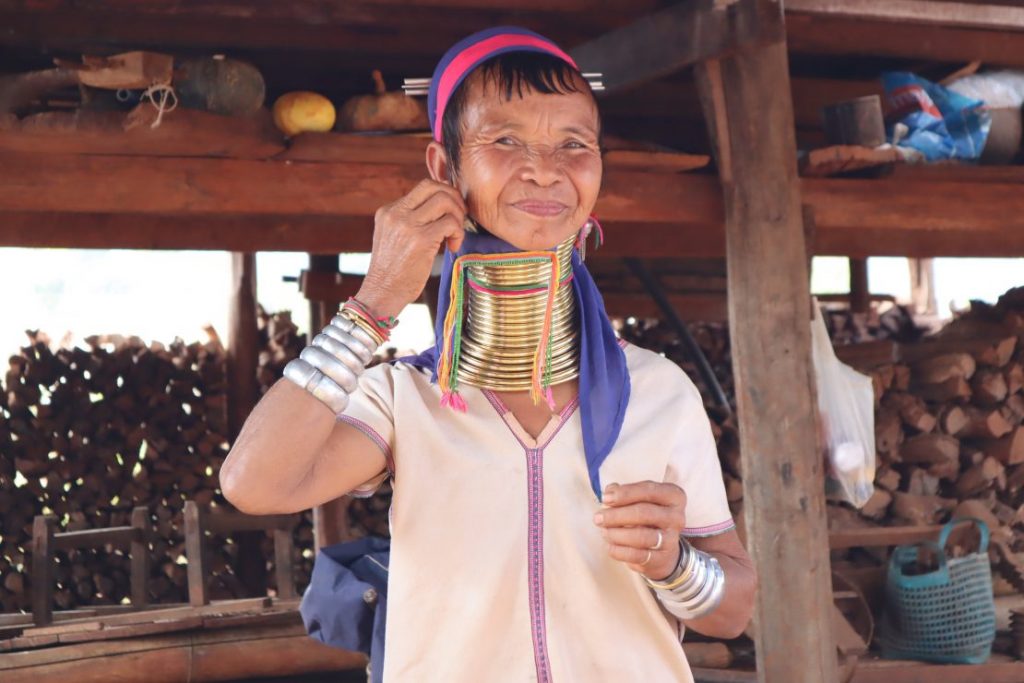
Dha Mu Ayea has three daughters, one son, and 19 grandchildren. Although she is disappointed that none of her daughters have chosen to continue the neck ring tradition, she accepts that it is their choice to make.
The tribal leaders used to require women to wear the neck rings, but the practice is now optional. Most girls and young women are choosing to not continue the tradition. For some it is because they are adopting more modern attitudes about dress, but for others, the decision is financial.
The brass neck rings used to be made in the neighboring Shan state. The Karen people would trade custom woven fabrics for brass rings with their Shan neighbors. But now the rings are made in Thailand and have become far too expensive for most.
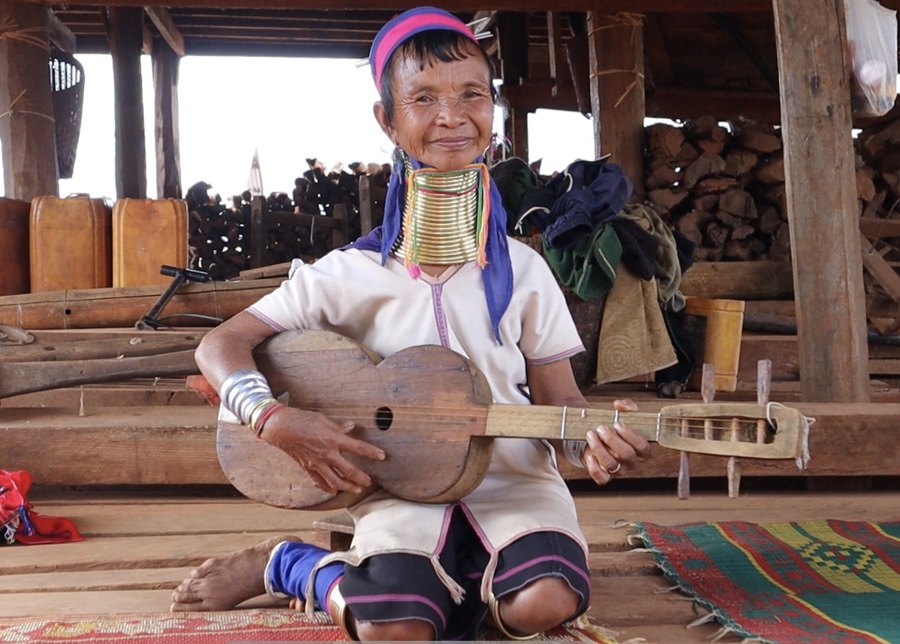
Finally, Dha Mu Ayea serenades us with her handmade guitar and Dale is smitten. It’s no secret that he harbors a soft spot for women who can strum a guitar and carry a tune (although I can do neither).
And when it is time for pictures, Dha Mu Ayea appears equally smitten with Dale.
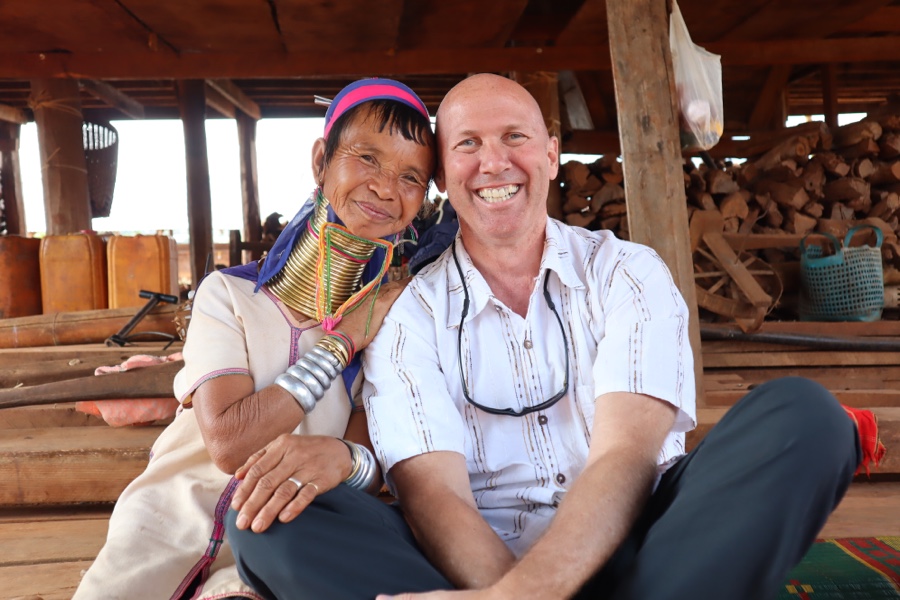
2. Kayah Tribe
Not too far from the Kayan village of Pan Pet is the Kayah village of Hta Nee La Leh. While the Kayan women are famous for wearing the brass neck rings, the Kayah women are recognized by their lacquer leg rings, signature red outfit, elaborate necklaces and massive earlobe holes.
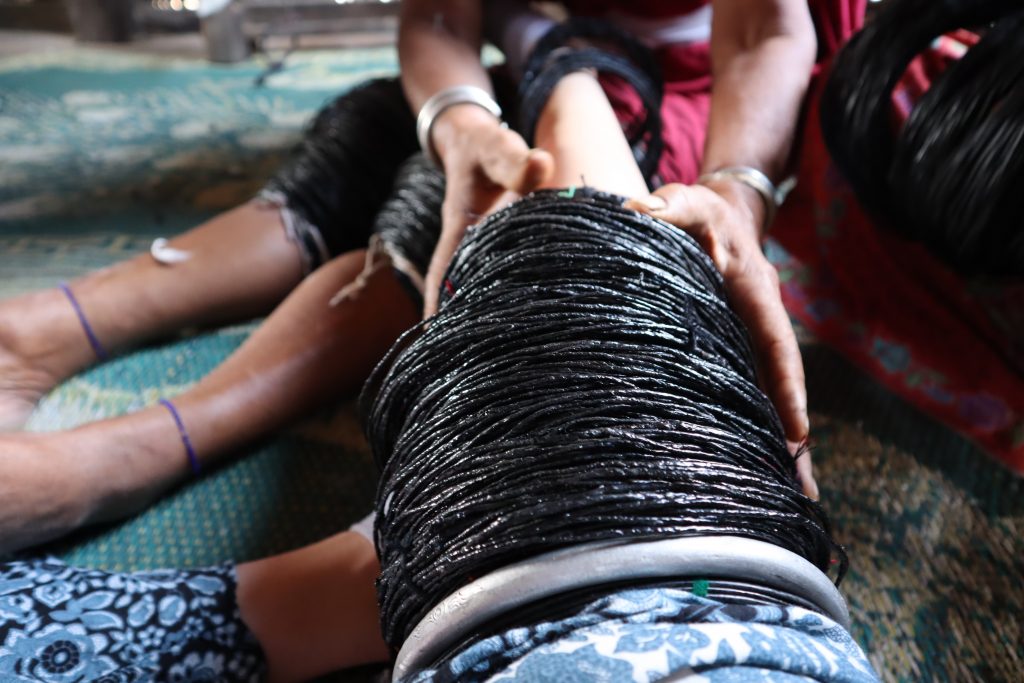
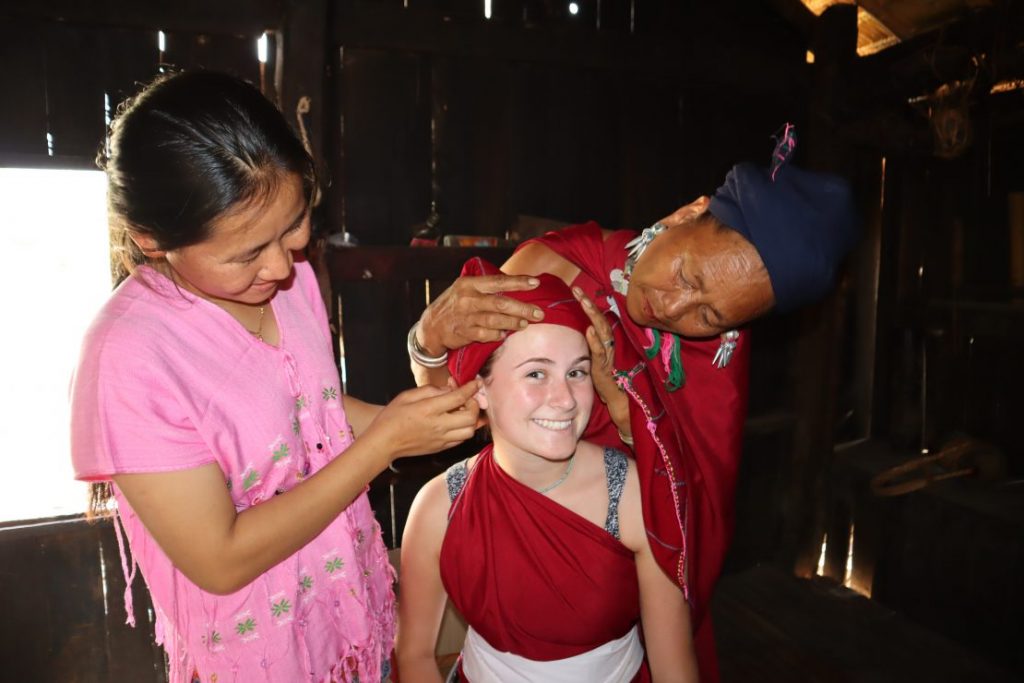
Upon our arrival, a couple of Kayah women quickly whisked Riley away to begin her makeover–Kayah style. Once they had donned Riley in the traditional attire, it was time for her photo op. Riley gained a quick appreciation for the difficulty of trying to walk with dozens of lacquer rings encircling her knees.
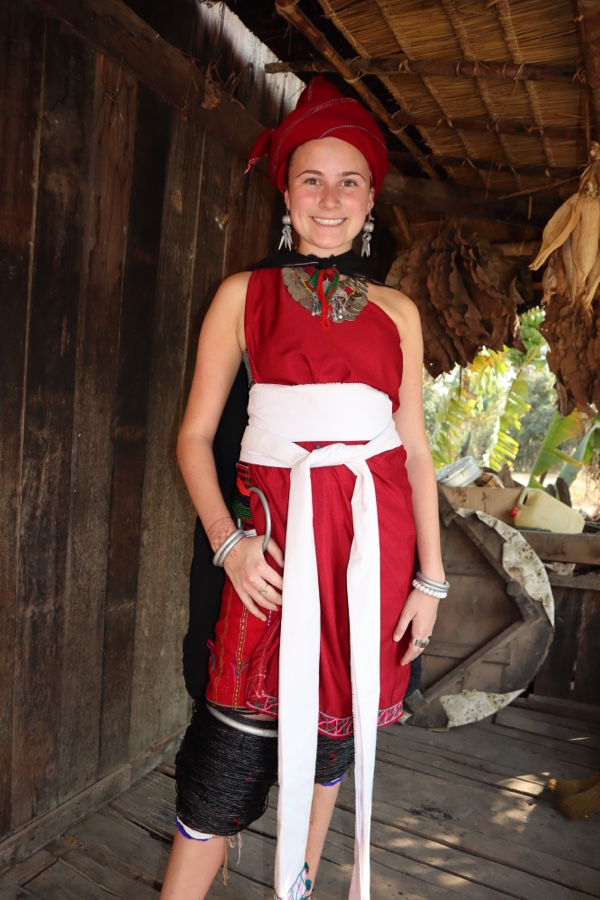
After Riley’s makeover, it was off to meet the town musicians, Daw Soe Myar and U Mi Reh. The married duo with 7 children and 30 grandchildren love entertaining visitors with their homemade instruments.

Dale’s fascination with the bamboo guitar ended with him purchasing theirs. He spent the final weeks of our sabbatical safeguarding the newest addition to his instrument collection.
3. Kayaw Tribe
Nestled in the mountains 2 1/2 hours from Loikaw, sits Htay Kho Village. This village is home of the Kayaw tribe. Like the Kayan and Kayah tribes, they dress in traditional attire unique to their tribe. However, their signature accessory is a sort of mash up of the other two. The Kayaw wear brass rings around their legs. And like they Kayah, they have massive earlobe holes too.
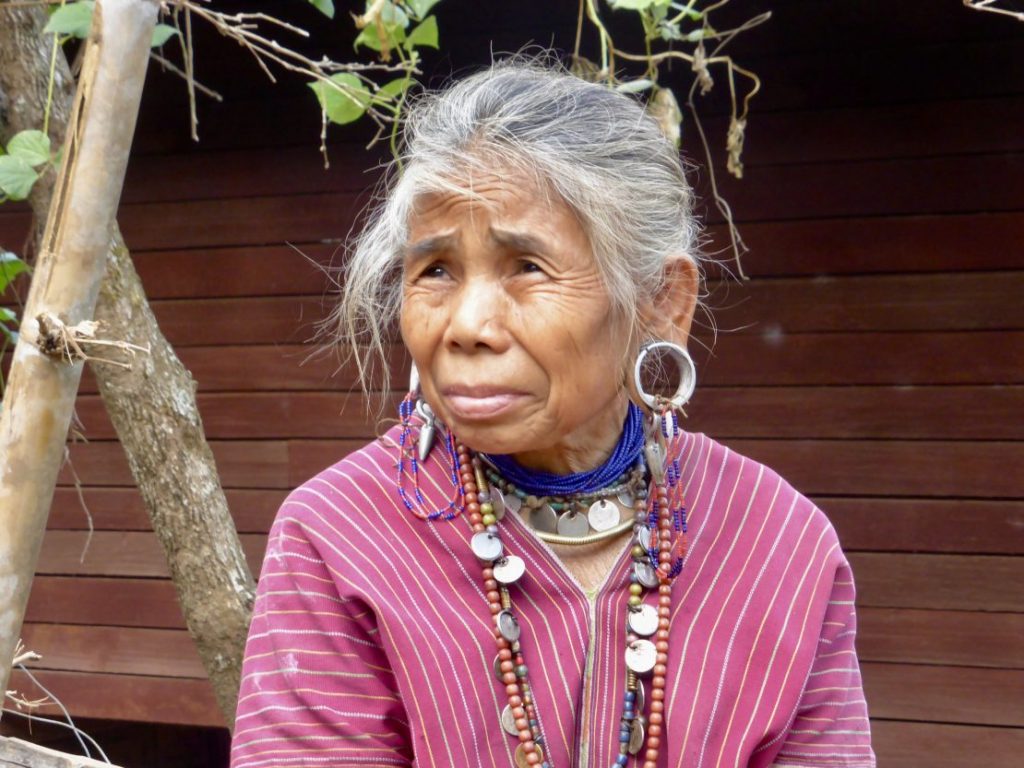

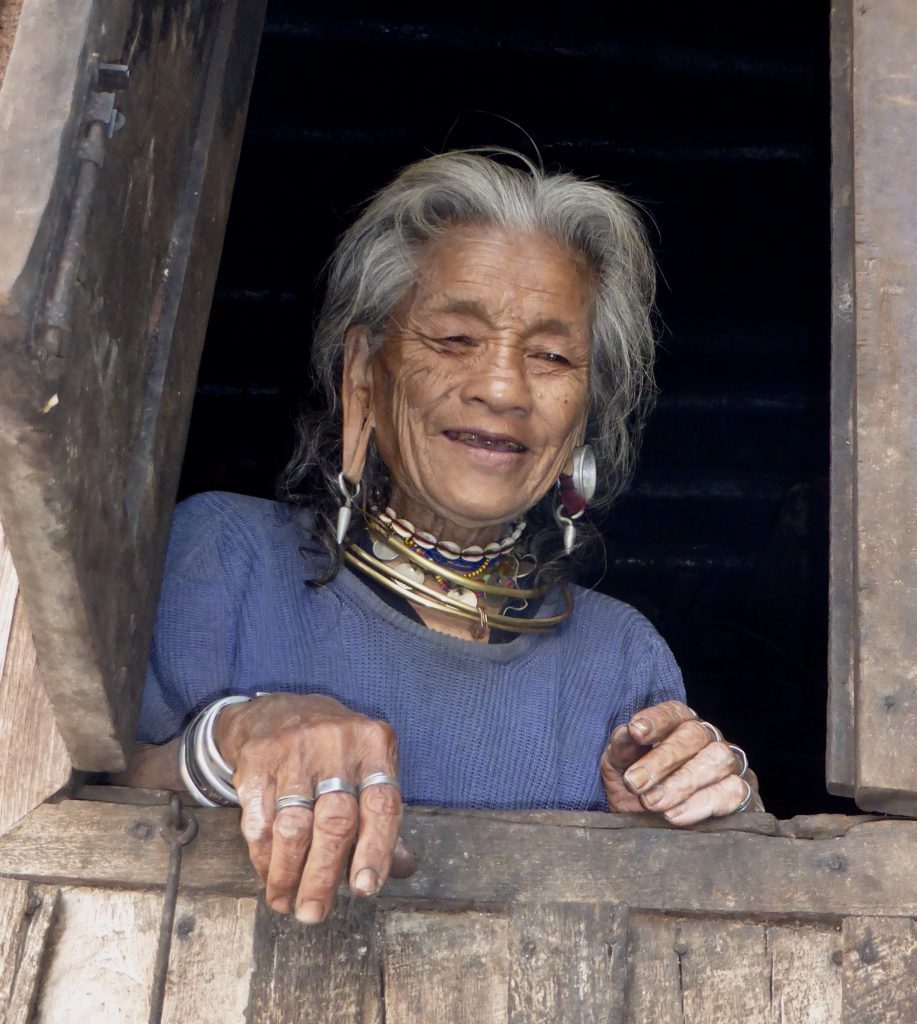
4 Tips for Visiting Myanmar’s Long Neck Women and Other Tribes
Before visiting Myanmar’s tribes or any other ethnic groups, be sure to follow these tips to ensure your experience is both meaningful to you and beneficial to those you visit.
1. Read From the Land of Green Ghosts .
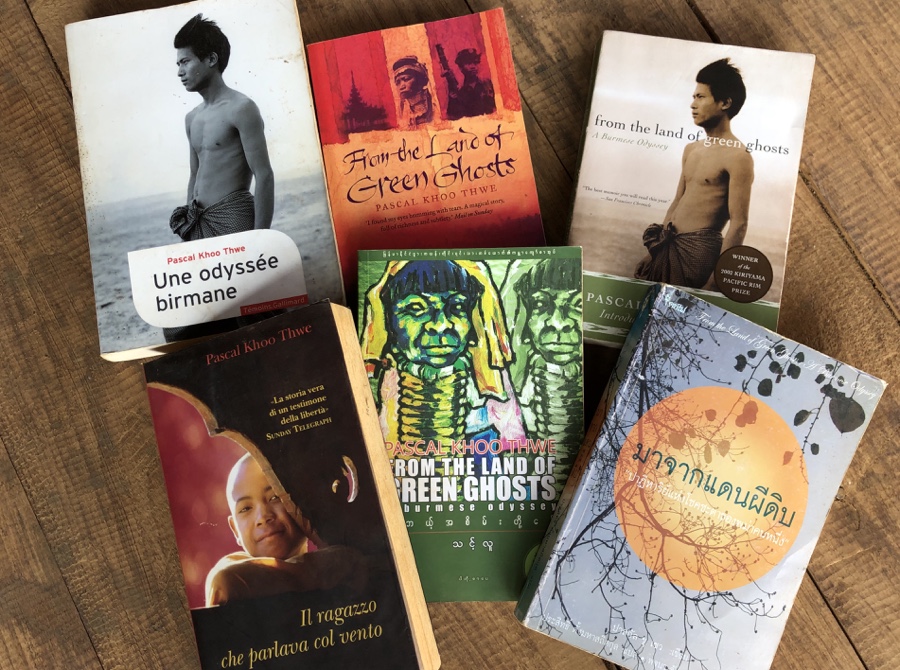
Myanmar’s recent history is complicated. Do yourself a huge favor and educate yourself a little before arriving. This is especially true if your itinerary includes visiting the minority ethnic groups. Pascal Khoo Thwe’s award winning autobiography originates in this area of the country. Your travel to Myanmar will be greatly enriched by reading this book first.
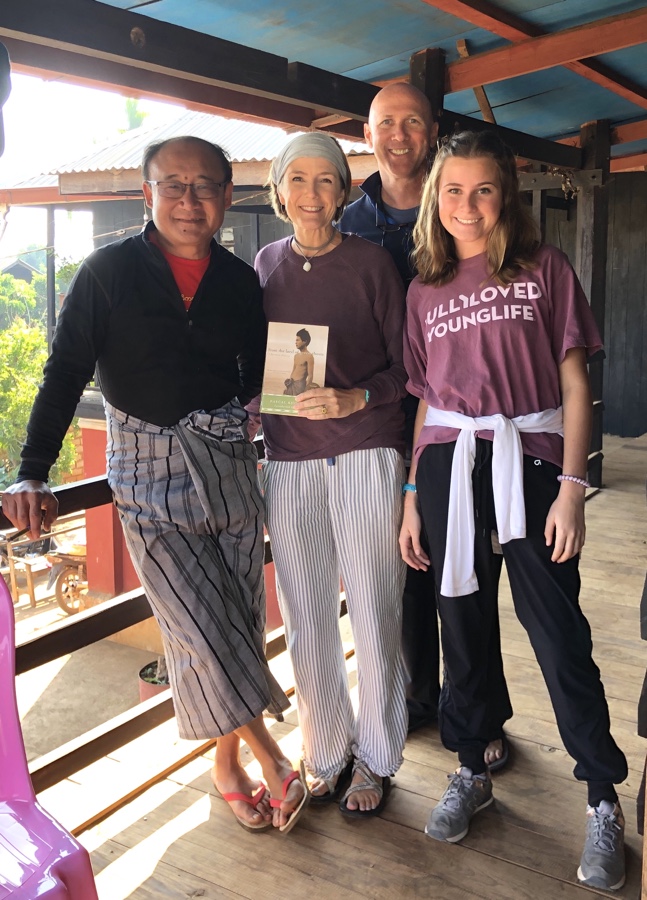
2. Visit independently with a local guide.
Do not visit with a tour group! The authentic experiences we had never would have happened if we had been in a group of 15 people, much less with a busload. They just wouldn’t. Don’t ruin this once-in-a-lifetime experience with a group of random people. Arrange a private visit with a Myanmar based tour company like Pro Niti Travel.
3. Conversation first. Camera second.
Whether you’re visiting these ethnic groups of Myanmar or somewhere else, get to know the people first. Having a real conversation with others is the best way to get the authentic experience that travelers seek.
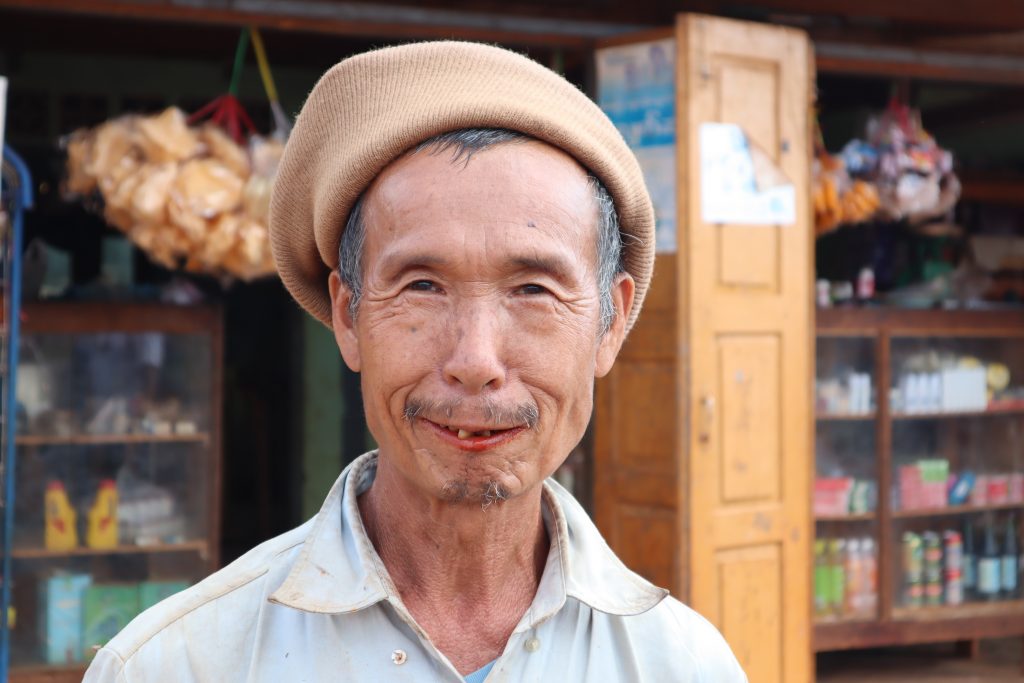
4. Watch this video of the Karen tribes.
Despite many negative traveler reports, it is possible to ethically visit Myanmar’s long neck women and other ethnic tribes. By following these tips, travelers can peek behind the curtain of the world’s most fascinating cultures without turning them into human zoos.

Ready to explore the world? Then check out THE PASSPORT PROJECT and THE ULTIMATE TRAVEL TRACKER to inspire and manage your wanderlust.


Interested in more epic adventures? Check out the following:
- Camping in Antarctica: Everything You Need to Know to Survive
- How to Save Thousands on Your Family’s Galapagos Adventure
- Ten Day Namibia Road Trip: Sand, Seals, and Safari
- How to Plan a Budget Vacation to the Luxurious Maldives
- How to Book an Amazing and Affordable South Africa Safari
- No Regrets: Bungee Jumping in Queenstown, New Zealand
- The Passport Project: A DIY Journey Around the World
Interested in more cultural adventures? Check out following:
- Three Tips for Ethically Visting Myanmar‘s Long-Neck Women
- How to Volunteer at Delhi’s Gurudwara Bangla Sahib Sikh Community Kitchen
- Burial, Cremation, and Reincarnation in Bali
- Learn to Meditate at Truc Lam, Da Lat, Vietnam’s Buddhist Monastery
- Family Travel Idea: Spend the Night with the Embera Puru Indians in Panama
- Don’t be Flashy! Guidelines for Luang Prabang’s Alms Giving Ceremony
- Cambodia‘s Genocide: What I Never Learned in School


[…] Tips for Ethically Visting Myanmar‘s Long-Neck […]
[…] These three tribes are easily visited from the town of Loikaw. For detailed information about visiting these fascinating people, be sure to check out these tips for ethically visiting Myanmar’s Long Neck women. […]